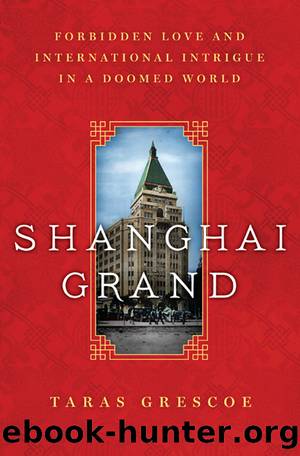Shanghai Grand by Taras Grescoe

Author:Taras Grescoe [Grescoe, Taras]
Language: eng
Format: epub
Publisher: St. Martin's Press
Published: 2016-05-11T00:00:00+00:00
When the fighting that signalled the outbreak of the Second Sino-Japanese War began, Sinmay discovered he was living in the worst possible location. The family home where Mickey Hahn had smoked her first opium pipe in Yangtzepoo, north of Soochow Creek, was also where the bulk of Shanghai’s Japanese population made their homes. Now diminutive marines wearing puttees and split-toe shoes marched through those same streets, while looters ransacked vacant homes. After Black Saturday, Sinmay packed up his five children and his most prized possessions in a van and drove with his family to his sister’s apartment in Frenchtown, where a dozen members of his household would share a single room.
After returning from Nanking, Mickey realized why her house in Yuyuen Road was such a bargain: it was located beyond the Settlement’s borders, in what could easily become a lawless combat zone. (The Western Roads district soon became a notorious haven for Japanese-run opium dens, brothels, and roulette houses.) When a plane swept so low it almost hit the chimney, she and Mary moved to an empty house off Avenue Joffre, a busy boulevard running through Frenchtown.
By 1937 the historic French Concession, which began south-east of the Race Course, was French in name only. Only 1,200 of its million citizens actually had French passports. They were vastly outnumbered by Shanghai’s 25,000 White Russians, who had made the mile-long Avenue Joffre into an unofficial “Moscow Boulevard” where bakeries posted Cyrillic signs advertising black bread, and tiny restaurants offered shots of vodka and bowls of borscht (a soup that features on many Shanghai menus to this day). In Frenchtown, brothels were licensed, and even such notorious prostitutes as the “Voluptuous Vampires from Vladivostok” (who shocked old Shanghailanders with their willingness to accept Chinese clients) were regularly inspected by doctors.
Unlike the cramped, commerce-driven International Settlement, Frenchtown was embellished by the panache of Gallic urbanism, which made it a favoured residential district for American and European diplomats. With the Old World charm of Tudor-style houses and faux Spanish villas on generous lots, and broad sidewalks shaded by plane trees, it was – and remains to this day – the only place in central Shanghai for an urban stroller to enjoy the pleasure of genuine Baudelairean flânerie. Such vestigial continental chic also made Frenchtown an ideal home for Sinmay. By December, Mickey had found the Zau family a home, nearly identical to her own, two doors to the west of her Avenue Joffre cottage. Soon the house was crowded with beds, wardrobes, spittoons, and newspapers stacked in corners. Sinmay would call Avenue Joffre home for the rest of his life.
After seeing the Zaus resettled, Mickey agreed to undertake a rescue mission. In the haste of their flight, the family had been forced to abandon their bulkiest possessions in the old home and office in Yangtzepoo. Now, Japanese sentries posted on the bridges over Soochow Creek turned back anybody without the proper papers – subjecting Europeans to slaps, and Chinese to prodding (or much worse) with their bayonets.
Download
This site does not store any files on its server. We only index and link to content provided by other sites. Please contact the content providers to delete copyright contents if any and email us, we'll remove relevant links or contents immediately.
| Africa | Asia |
| Canadian | Europe |
| Holocaust | Latin America |
| Middle East | United States |
Fanny Burney by Claire Harman(25784)
Empire of the Sikhs by Patwant Singh(22173)
Out of India by Michael Foss(16312)
Leonardo da Vinci by Walter Isaacson(11903)
Small Great Things by Jodi Picoult(6095)
The Six Wives Of Henry VIII (WOMEN IN HISTORY) by Fraser Antonia(4791)
The Wind in My Hair by Masih Alinejad(4424)
The Lonely City by Olivia Laing(4120)
The Crown by Robert Lacey(4105)
A Higher Loyalty: Truth, Lies, and Leadership by James Comey(4033)
The Iron Duke by The Iron Duke(3639)
Millionaire: The Philanderer, Gambler, and Duelist Who Invented Modern Finance by Janet Gleeson(3569)
Sticky Fingers by Joe Hagan(3454)
Alive: The Story of the Andes Survivors by Piers Paul Read(3312)
Papillon (English) by Henri Charrière(3270)
Joan of Arc by Mary Gordon(3259)
Stalin by Stephen Kotkin(3086)
Aleister Crowley: The Biography by Tobias Churton(3021)
Ants Among Elephants by Sujatha Gidla(2925)
